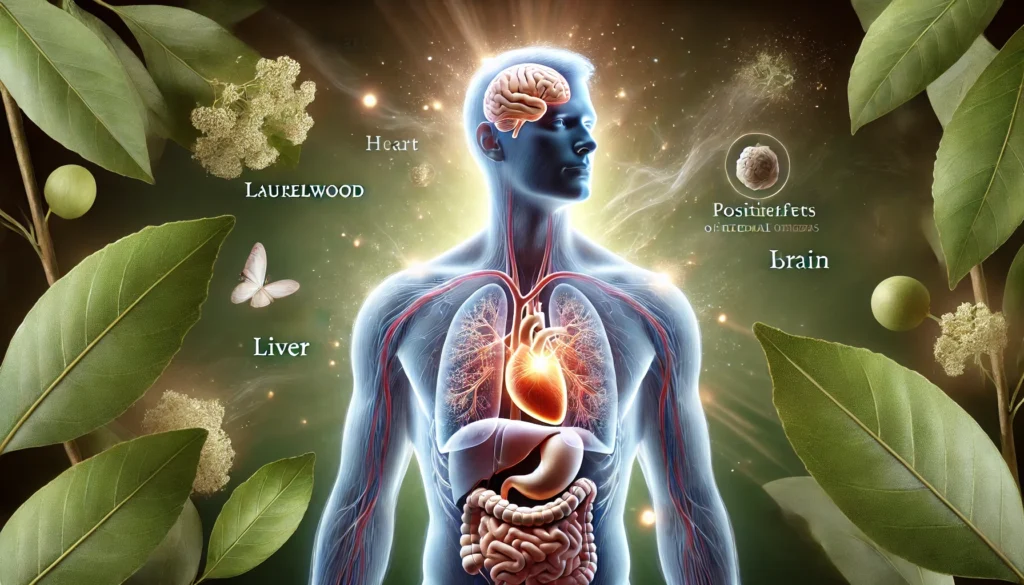Laurelwood is an herbal supplement that has been traditionally used in natural medicine for its potential health benefits, including its anti-inflammatory, antimicrobial, and cognitive-enhancing properties. While its use as a nootropic is still under scientific exploration, preliminary research and historical accounts suggest that Laurelwood may offer neuroprotective effects, support cognitive function, and promote overall brain health. This article provides a comprehensive examination of Laurelwood’s sources, chemistry, physiological mechanisms, nootropic benefits, recommended dosages, safety considerations, potential drug interactions, and contraindications for certain individuals.
You May Also Like:
Sources of Laurelwood
Laurelwood, commonly associated with trees of the Lauraceae family, is found in various species across North America, Europe, and Asia. It thrives in temperate regions and is often used for its aromatic leaves, bark, and essential oils. The primary sources of Laurelwood supplements include:
- Bark Extracts: Traditionally used for medicinal purposes, containing concentrated bioactive compounds.
- Leaves: Used in herbal teas and tinctures, contributing to its cognitive and digestive benefits.
- Essential Oils: Extracted from the bark and leaves, offering therapeutic effects due to its high terpene content.
- Powdered Form: Available as a dietary supplement in capsules or bulk powder for convenience in supplementation.
Chemistry of Laurelwood
The nootropic effects of Laurelwood are primarily attributed to its rich phytochemical composition, which includes:
- Terpenoids: Such as linalool and cineole, which have neuroprotective and anti-inflammatory properties.
- Flavonoids: Including quercetin and kaempferol, which offer antioxidant benefits and support synaptic function.
- Phenolic Acids: Such as caffeic acid and gallic acid, known for their ability to reduce oxidative stress.
- Alkaloids: Potentially influencing neurotransmitter regulation.
These bioactive compounds interact with neurological pathways to enhance cognitive function and protect neurons from damage caused by oxidative stress and inflammation.

Physiological Mechanisms of Laurelwood in the Body and Brain
1. Neuroprotection and Antioxidant Activity
The high flavonoid and phenolic acid content in Laurelwood contributes to its antioxidant properties, helping neutralize free radicals that can damage brain cells. This protection is essential in preventing cognitive decline and neurodegenerative diseases.
2. Modulation of Neurotransmitter Activity
Some alkaloids found in Laurelwood are believed to interact with neurotransmitter systems, particularly dopamine and acetylcholine pathways. These interactions may help enhance memory, focus, and overall cognitive function.
3. Anti-inflammatory Effects
Chronic inflammation in the brain has been linked to neurodegenerative conditions such as Alzheimer’s and Parkinson’s disease. Laurelwood’s terpenoids and flavonoids have been shown to reduce neuroinflammation, potentially supporting long-term brain health.
4. Enhancement of Cerebral Blood Flow
Improved circulation to the brain ensures a steady supply of oxygen and nutrients, which are crucial for mental clarity and cognitive endurance. Certain compounds in Laurelwood may help improve blood vessel elasticity and reduce oxidative damage to the vascular system.
5. Gut-Brain Axis Modulation
Emerging research highlights the relationship between gut health and brain function. Laurelwood’s phenolic compounds may positively influence gut microbiota, leading to improved mood regulation and cognitive performance.
Potential Nootropic Benefits of Laurelwood
1. Memory and Learning Enhancement
The flavonoids and alkaloids in Laurelwood contribute to improved synaptic plasticity, which is essential for memory formation and learning capabilities. This makes it a potential supplement for students and professionals seeking cognitive enhancement.
2. Stress Reduction and Mood Support
Laurelwood’s terpenoid compounds, such as linalool, may exert anxiolytic effects by modulating the GABAergic system. This could help reduce stress and anxiety levels while promoting a balanced mood.
3. Protection Against Cognitive Decline
The combination of antioxidants and anti-inflammatory compounds in Laurelwood helps protect neurons from oxidative stress and inflammation, which are primary contributors to neurodegeneration.
4. Increased Focus and Attention
By influencing dopamine pathways, Laurelwood may enhance attention span and concentration, making it a potential supplement for individuals with attention disorders or those seeking enhanced mental clarity.
5. Sleep Quality Improvement
Some evidence suggests that Laurelwood may promote relaxation and improve sleep patterns due to its effects on the central nervous system. Enhanced sleep quality contributes to better cognitive function and memory retention.

Dosage and Supplementation Guidelines
There is currently no universally established dosage for Laurelwood as a nootropic, but general guidelines based on traditional use and existing research suggest:
- Tea or Infusion: 1-2 teaspoons of dried leaves steeped in hot water, taken once or twice daily.
- Capsules or Powder: 300-600 mg per day, preferably standardized for flavonoid and terpene content.
- Tinctures: 1-3 mL taken up to three times daily, depending on concentration.
It is advisable to start with a lower dose and gradually increase based on individual response and tolerance.
Side Effects and Safety Considerations
While Laurelwood is generally well tolerated, potential side effects may include:
- Gastrointestinal Discomfort: Some individuals may experience bloating or nausea, particularly when taken in high doses.
- Allergic Reactions: Those with sensitivities to plants in the Lauraceae family should exercise caution.
- Drowsiness: Due to its mild sedative effects, high doses may cause drowsiness or fatigue.
- Potential Toxicity: Excessive consumption of essential oils from Laurelwood can be toxic, particularly in concentrated forms.
Interactions with Other Supplements and Medications
Laurelwood may interact with several drugs and supplements, necessitating caution in certain cases:
- Blood Thinners: Some phenolic compounds in Laurelwood may affect blood clotting, requiring caution when taken alongside anticoagulants.
- Sedatives and Anxiolytics: The mild sedative effects of Laurelwood may amplify the effects of medications such as benzodiazepines.
- Nootropic Stacks: While it may complement other nootropics like Ginkgo biloba or Rhodiola rosea, careful dosage adjustments are recommended to avoid overstimulation or drowsiness.
- Antihypertensive Medications: Some reports suggest Laurelwood may have mild blood pressure-lowering effects, necessitating monitoring when used with prescription medications.
Risks for Individuals with Certain Health Conditions
- Pregnant and Breastfeeding Women: There is limited research on the safety of Laurelwood during pregnancy and lactation; thus, supplementation should be avoided.
- Liver or Kidney Conditions: Due to its bioactive compounds, individuals with pre-existing liver or kidney conditions should consult a healthcare provider before use.
- Neurological Disorders: While Laurelwood may offer cognitive benefits, individuals with epilepsy or other neurological disorders should use it cautiously due to its potential effects on neurotransmitter systems.
Conclusion: Should You Consider Laurelwood as a Nootropic?
Laurelwood presents a promising option for cognitive enhancement, neuroprotection, and mood support. With its rich profile of flavonoids, terpenes, and phenolic acids, it offers multiple pathways for improving brain health. However, while preliminary research supports its potential benefits, more extensive studies are needed to establish its efficacy and safety profile in the context of nootropic supplementation.
Individuals interested in exploring Laurelwood as a supplement should begin with conservative dosages, monitor their response, and consult a healthcare provider if they have pre-existing medical conditions or are taking prescription medications. As with all supplements, responsible usage is essential to maximize benefits while minimizing potential risks.
In summary, Laurelwood’s antioxidant, anti-inflammatory, and neurotransmitter-modulating properties make it a compelling candidate for nootropic use. Further research will help refine its application in cognitive health and optimize its integration into nootropic regimens for enhanced mental performance and well-being.

References:
- Laurelwood – Uses, Side Effects, and More. Retrieved from: https://www.webmd.com/vitamins/ai/ingredientmono-782/laurelwood
- Beneficial Effects of Laurel (Laurus nobilis L.) and Myrtle (Myrtus communis L.) Extract on Rat Health. Retrieved from: https://pmc.ncbi.nlm.nih.gov/articles/PMC8778765/
Important Note: The information contained in this article is for general informational purposes only, and should not be construed as health or medical advice, nor is it intended to diagnose, prevent, treat, or cure any disease or health condition. Before embarking on any diet, fitness regimen, or program of nutritional supplementation, it is advisable to consult your healthcare professional in order to determine its safety and probable efficacy in terms of your individual state of health.
Regarding Nutritional Supplements Or Other Non-Prescription Health Products: If any nutritional supplements or other non-prescription health products are mentioned in the foregoing article, any claims or statements made about them have not been evaluated by the U.S. Food and Drug Administration, and such nutritional supplements or other health products are not intended to diagnose, treat, cure, or prevent any disease.


